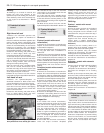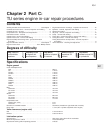
Centre cover
2 Remove the upper cover as described in
paragraph 1, then free the wiring from its
retaining clips on the centre cover.
3 Slacken and remove the three retaining
bolts (one at the rear of the cover, beneath the
engine mounting plate, and two directly above
the crankshaft pulley), and manoeuvre the
centre cover out from the engine
compartment (see illustration).
Lower cover
4 Remove the auxiliary drivebelt as described
in Chapter 1.
5 Remove the upper and centre covers as
described in paragraphs 1 to 3.
6 Undo the three crankshaft pulley retaining
bolts and remove the pulley, noting which way
round it is fitted (see illustrations).
7 Slacken and remove the single retaining
bolt, and slide the lower cover off the end of
the crankshaft (see illustration).
Refitting
Upper cover
8 Refit the cover, ensuring it is correctly
located with the centre cover, and tighten its
retaining bolts.
Centre cover
9 Manoeuvre the centre cover back into
position, ensuring it is correctly located with
the lower cover, and tighten its retaining bolts.
10 Clip the wiring loom into its retaining clips
on the front of the centre cover, then refit the
upper cover as described in paragraph 8.
Lower cover
11 Locate the lower cover over the timing
belt sprocket, and tighten its retaining bolt.
12 Fit the pulley to the end of the crankshaft,
ensuring it is fitted the correct way round, and
tighten its retaining bolts to the specified
torque.
13 Refit the centre and upper covers as
described above, then refit and tension the
auxiliary drivebelt as described in Chapter 1.
7 Timing belt - general
information, removal and
refitting
3
Note: Peugeot specify the use of a special
electronic tool (SEEM C.TRONIC type 105 belt
tensioning measuring tool) to correctly set the
timing belt tension. If access to this equipment
cannot be obtained, an approximate setting
can be achieved using the method described
below. If the method described is used, the
tension must be checked using the special
electronic tool at the earliest possible
opportunity. Do not drive the vehicle over
large distances, or use high engine speeds,
until the belt tension is known to be correct.
Refer to a Peugeot dealer for advice.
General information
1 The timing belt drives the camshaft and
coolant pump from a toothed sprocket on the
front of the crankshaft. If the belt breaks or
slips in service, the pistons are likely to hit the
valve heads, resulting in extensive (and
expensive) damage.
2 The timing belt should be renewed at the
specified intervals (see Chapter 1), or earlier if
it is contaminated with oil, or if it is at all noisy
in operation (a “scraping” noise due to uneven
wear).
3 If the timing belt is being removed, it is a
wise precaution to check the condition of the
coolant pump at the same time (check for
signs of coolant leakage). This may avoid the
need to remove the timing belt again at a later
stage, should the coolant pump fail.
Removal
4 Disconnect the battery negative lead.
5 Align the engine assembly/valve timing
holes as described in Section 3, and lock both
the camshaft sprocket and the flywheel in
position. Do not attempt to rotate the engine
whilst the locking tools are in position.
6 Remove the timing belt centre and lower
covers as described in Section 6.
7 Loosen the timing belt tensioner pulley
retaining nut. Pivot the pulley in a clockwise
direction, using a square-section key fitted to
the hole in the pulley hub, then retighten the
retaining nut.
8 If the timing belt is to be re-used, use white
paint or similar to mark the direction of
rotation on the belt (if markings do not already
exist) (see illustration). Slip the belt off the
sprockets.
9 Check the timing belt carefully for any signs
of uneven wear, splitting, or oil contamination.
Pay particular attention to the roots of the
teeth. Renew the belt if there is the slightest
doubt about its condition. If the engine is
undergoing an overhaul, and has covered
more than 36 000 miles (60 000 km) with the
existing belt fitted, renew the belt as a matter
of course, regardless of its apparent
condition. The cost of a new belt is nothing
when compared to the cost of repairs, should
the belt break in service. If signs of oil
contamination are found, trace the source of
the oil leak, and rectify it. Wash down the
engine timing belt area and all related
components, to remove all traces of oil.
Refitting
10 Prior to refitting, thoroughly clean the
timing belt sprockets. Check that the tensioner
TU series engine in-car repair procedures 2C•5
2C
6.3 . . . then undo the three bolts (locations
arrowed) and remove the centre cover
6.6a Undo the three bolts (arrowed) . . . 6.6b . . . and remove the crankshaft pulley
6.7 Undo the retaining bolt and remove
the timing belt lower cover
7.8 Mark the direction of rotation on the
belt if it is to be re-used


















